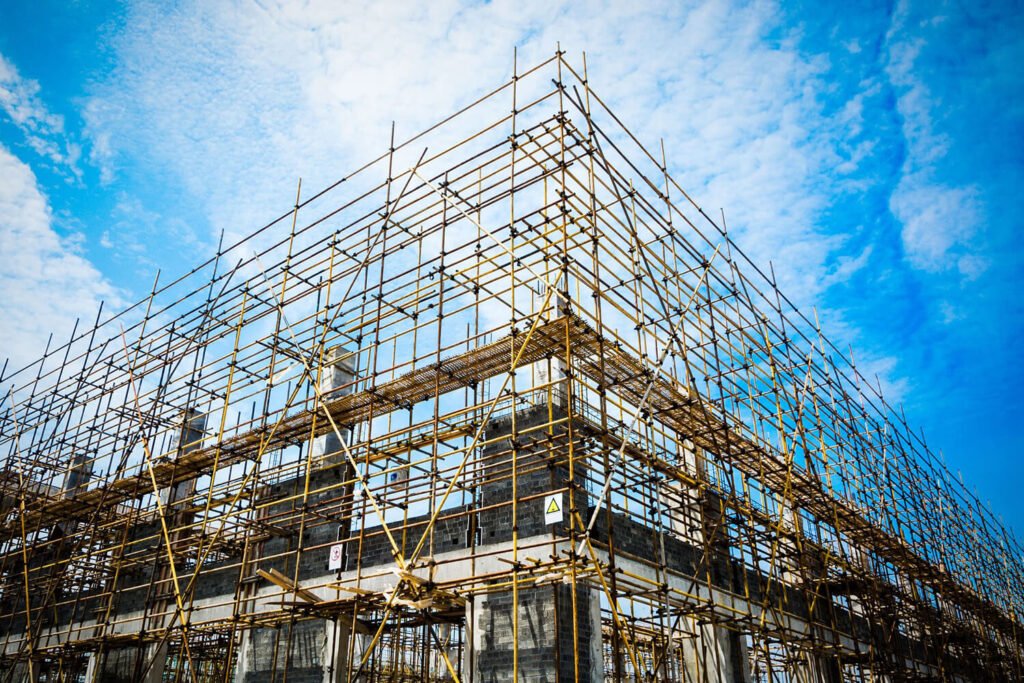Safe and Durable Scaffolding Guildford for Your Upcoming Construction Work
Checking Out the Various Kinds of Scaffolding Used in Building And Construction Jobs
The construction market depends greatly on numerous kinds of scaffolding to fulfill specific task needs, each offering distinct advantages and applications. Standard framework scaffolding offers a tough structure for basic tasks, while suspended scaffolding is necessary for work on skyscraper frameworks.

Conventional Framework Scaffolding
Standard frame scaffolding is among the most extensively utilized methods in the building industry due to its toughness and convenience. This system consists of straight and vertical frameworks that are put together to develop a steady system for employees and products. The major components include vertical blog posts, horizontal journals, and angled dental braces, which with each other give a strong structure that can sustain substantial loads.
Among the vital advantages of traditional structure scaffolding is its versatility to various building jobs, ranging from property structures to huge industrial structures. The modular design enables for very easy assembly and disassembly, making it reliable for both lasting and short-term projects. Furthermore, the system can be personalized in height and width, fitting various building layouts and site problems.
Safety is critical in scaffolding applications, and standard structure systems are equipped with guardrails and toe boards to prevent drops and ensure employee protection. Normal examinations and adherence to safety regulations are vital in maintaining the stability of the scaffold (Scaffolding). Overall, conventional frame scaffolding continues to be an essential selection in the building sector, supplying a dependable system for labor and boosting overall project effectiveness

Suspended Scaffolding
Put on hold scaffolding provides an one-of-a-kind remedy for building jobs that call for accessibility to raised surface areas, especially in circumstances where conventional frame scaffolding might be impractical. This kind of scaffolding is normally suspended from the roof or top degrees of a structure, using a system of ropes, wheels, and platforms to develop a functioning space that can be adjusted to numerous elevations.
Among the primary advantages of put on hold scaffolding is its versatility. It can be conveniently repositioned or lowered to accommodate changes in building requirements, making it suitable for jobs such as home window setup, frontage job, and maintenance on skyscrapers. In addition, the very little impact of put on hold scaffolding allows for better use of ground area in metropolitan atmospheres, where area is frequently limited.
Safety is a critical factor to consider in the use of put on hold scaffolding. On the whole, put on hold scaffolding offers a effective and reliable option for accessing hard-to-reach areas in various construction scenarios, boosting both efficiency and security on site.
System Scaffolding
System scaffolding, usually related to as a contemporary option in the scaffolding industry, is composed of pre-engineered components that can be quickly assembled and adjusted for various building and construction tasks. Scaffolding. This kind of scaffolding is defined by its modular design, which permits flexibility and performance on job websites, fitting various heights and architectural demands
Normally made from high-strength steel or aluminum, system scaffolding supplies enhanced longevity and security. The components consist of upright messages, straight ledgers, and diagonal braces, which adjoin securely, making sure a robust framework. The style often includes standardized fittings, simplifying assembly and disassembly processes, therefore decreasing labor time and expenses.

Rolling Scaffolding
Rolling scaffolding is a functional option to traditional set scaffolding, made for scaffold design calculations flexibility and simplicity of use on building and construction websites. This kind of scaffolding includes a system supported by frames with wheels, enabling workers to conveniently relocate it as required. The wheelchair feature dramatically improves productivity, as it decreases downtime connected with assembling and dismantling repaired scaffolding.
Typically created from light-weight products such as light weight aluminum or steel, rolling scaffolding provides a tough yet portable remedy for tasks needing constant repositioning - Scaffolding. It is particularly beneficial in jobs such as painting, drywall setup, and electric job, where accessibility to numerous heights and areas is necessary
Security is vital in rolling i thought about this scaffolding layout, with features such as securing wheels to avoid unintentional motion when being used, and guardrails to protect workers from drops. In addition, many designs are flexible in height, suiting various project requirements.
Cantilever Scaffolding

The style of cantilever scaffolding usually involves making use of brackets or arms anchored to a structure or structure, making it possible for the system to expand exterior safely. Safety and security is critical; hence, these scaffolds must be crafted to stand up to various tons and environmental conditions. Normal evaluation and maintenance are vital to guarantee structural integrity and employee safety and security.
Cantilever scaffolding is favored for its convenience and effective use area, making it a popular option in urban atmospheres where space restrictions prevail. It promotes easier access to high altitudes, ultimately contributing to the general efficiency of building and construction projects. Similar to all scaffolding kinds, proper training and adherence to safety criteria are critical for workers using cantilever scaffolding.
Final Thought
Finally, the diverse kinds of scaffolding used in building jobs each offer distinctive objectives customized to specific site needs. Typical structure scaffolding provides stability, while put on hold scaffolding uses adaptability for raised jobs. System scaffolding assists in fast assembly, and rolling scaffolding enhances movement for varying job settings. Cantilever scaffolding properly resolves barriers in city settings. Understanding these scaffolding types is essential for optimizing safety and efficiency in building, ultimately contributing to the effective completion of projects.
Standard frame scaffolding gives a strong foundation for general jobs, while put on hold scaffolding is important for job on skyscraper frameworks.Rolling scaffolding is a functional option to traditional fixed scaffolding, created for movement and convenience of use on building and construction sites. As with all scaffolding types, correct training and adherence to security criteria are crucial for workers using cantilever scaffolding.
Conventional structure scaffolding provides security, while put on hold scaffolding uses versatility for elevated jobs. System scaffolding helps with fast assembly, and rolling scaffolding improves flexibility for varying job settings.